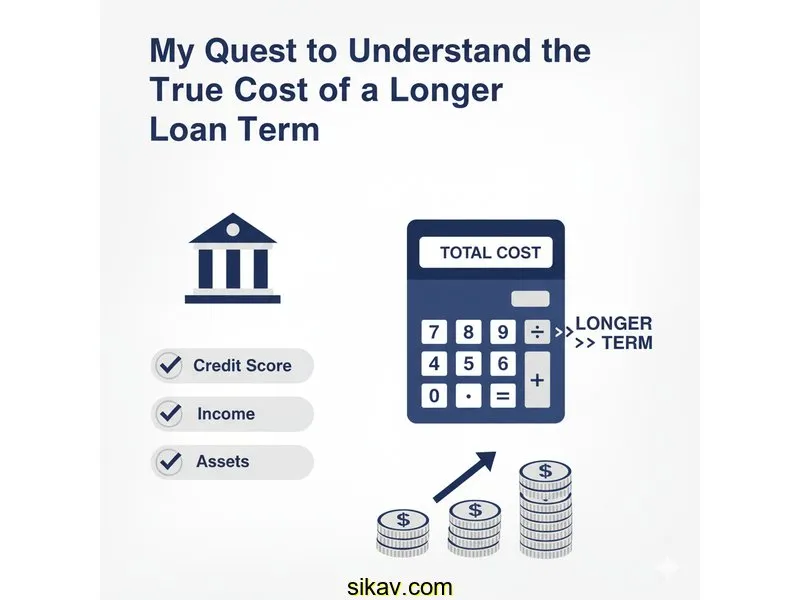
Auto Loan Calculator
Calculate payments over the life of your Loan
Home Blog Privacy Terms About Contact
Calculate payments over the life of your Loan
Home Blog Privacy Terms About ContactPublished on October 14, 2025

It all started with a simple chat over coffee with a coworker. They were excited about a recent purchase and mentioned they’d opted for a 60-month loan instead of a 36-month one because the monthly payment was "so much more manageable." I nodded along, thinking, "That makes sense. A lower payment is always better, right?" But later that day, a question started nagging at me. It felt like a little math puzzle that my brain couldn't let go of.
If the loan amount and interest rate were the same, how could one option be so much cheaper per month? There had to be a trade-off, but I couldn't immediately grasp what it was. Was the lower payment an illusion of savings? How much extra was my coworker really paying for the convenience of that smaller monthly bill? This wasn't about judging their decision; it was about my own lack of understanding. I realized I had no idea how the length of a loan—the term—truly affected the total cost.
My goal became clear: I needed to understand the mechanics behind this. I wasn't trying to find the "best" loan; I was trying to learn how to read the language of loans. I wanted to see the numbers, play with them, and understand the relationship between the loan term, the monthly payment, and the total amount of interest paid over time. This is purely about my journey to understand how the calculations work, not to offer any financial advice.
I decided to jump online and find a loan calculator. I figured I'd plug in some numbers and the answer would just appear. As I quickly learned, seeing the answer and understanding it are two very different things. My initial attempts only led to more confusion and a deeper realization that I was missing a key piece of the puzzle.
Armed with my newfound curiosity, I set up a hypothetical scenario. I imagined I needed a loan for $14,850 and found a sample interest rate of 7.8%. My plan was simple: I'd use an online calculator to compare a 36-month term with a 60-month term. I was focused on one thing and one thing only: the monthly payment.
I typed in the first set of numbers:
The calculator instantly gave me a monthly payment of around $466.82. "Okay, that's my baseline," I thought. Then, I changed just one number—the term.
The new monthly payment was $302.34. My initial reaction was exactly what my coworker had described. Wow! That's over $164 less each month. It felt like a massive, undeniable saving. For a moment, I thought, "Why would anyone choose the shorter term? This seems like a no-brainer." The math seemed to be telling me that the longer loan was the "cheaper" option.
But that nagging feeling wouldn't go away. It just didn't feel right. How could stretching out the payments result in such a better deal without a catch? I stared at the two monthly payment figures, feeling frustrated. I knew I was missing something fundamental. I was looking at a dashboard with only one dial, completely ignoring the others. My mistake was equating a lower monthly payment with a lower overall cost. I wasn't calculating the *total* cost at all; I was just comparing two isolated numbers without any context.
My "aha!" moment didn't come from a complex formula but from a better tool. I found a more detailed online loan calculator—one that had extra output fields beyond just the monthly payment. It had lines for "Total Principal Paid," "Total Interest Paid," and "Total of all Payments." Suddenly, I had the other dials on the dashboard I'd been missing.
This was where everything clicked. I ran my exact same scenario again. First, the 36-month loan. The calculator showed the $466.82 monthly payment, but below it were the numbers that changed everything: the total interest paid would be $1,955.52. Then, I plugged in the 60-month loan. I saw the temptingly low $302.34 monthly payment, but then my eyes locked on the total interest: $3,290.40. I had to read it twice.
By choosing the longer term to save $164 per month, my hypothetical self would pay an extra $1,334.88 in interest over the life of the loan. It wasn't a "cheaper" option at all; it was a more expensive one, just spread out over more time. The convenience of a lower payment had a very specific, calculable cost. It was right there in plain sight, and I had been completely blind to it.
Once I knew what to look for, the math wasn't scary anymore. It was empowering. The core idea I had missed was that interest is calculated on the remaining balance each month. When you have a longer term, your principal balance goes down more slowly. This means you are paying interest on a higher balance for a greater number of months, which allows much more total interest to accumulate.
The final piece of the puzzle fell into place when I clicked the "Show Amortization Schedule" button. This generated a table showing every single payment for the life of the loan, broken down into principal and interest. Comparing the 36-month schedule to the 60-month one was a revelation. In the first year of the 60-month loan, a huge chunk of each payment was going straight to interest. In the 36-month loan, the principal was being paid down much more aggressively from the very beginning.
To confirm my new understanding, I started playing with different numbers. I tried a $21,500 loan at 6.2% over 48 months versus 72 months. The principle was exactly the same: the 72-month loan had a much lower monthly payment but a drastically higher total interest cost. The relationship held true no matter what numbers I used. I wasn't just seeing answers anymore; I was finally understanding the logic behind them.
This journey down the rabbit hole of loan calculators taught me so much about how to approach these numbers. It wasn't about finding a "good" or "bad" loan, but about learning to interpret the information accurately. Here are the key lessons I learned about the calculations themselves:

From what I've learned, the term is one of the most powerful factors. A longer term means you are paying down your principal balance more slowly. Since interest is calculated on the remaining balance each month, a higher balance for more months results in a greater total amount of interest paid over the life of the loan.
This was a misconception I had early on. The interest rate is an annual rate (APR), but loan interest is typically calculated and compounded monthly on the outstanding balance. It's not a simple one-time multiplication. Each month, the interest is recalculated on a slightly smaller principal amount, and the math is much more complex, which is why calculators are so helpful.
It's a payment-by-payment breakdown. When you compare a short-term and long-term amortization schedule side-by-side for the same loan amount, you can visually see the difference. You'll notice that for the longer-term loan, a much larger portion of your initial payments goes toward interest, meaning you build equity much slower.
I found the best way is to keep all variables the same except for one. For instance, use the same loan amount and interest rate, but compare a 3-year, 4-year, and 5-year term. This isolates the effect of the loan term and clearly shows you the trade-off between the monthly payment amount and the total interest paid.
My biggest takeaway from this whole experience wasn't about saving money or making a specific choice. It was about gaining confidence. Before, the relationship between loan variables felt like a mystery. Now, it feels like a logical system that I can explore and understand. Seeing how a longer term directly increased the total interest cost wasn't just an answer; it was an insight into how the financial world is built on straightforward, learnable math.
I no longer see a loan payment as a single, isolated number. I see it as one part of a larger, interconnected equation. Learning to look for the "Total Interest Paid" field gave me the context I was missing. It's a skill of financial literacy that has nothing to do with what you should do, but everything to do with understanding what you're looking at.
I truly encourage anyone who feels intimidated by these numbers to open an online calculator and just start playing. Change the term, adjust the rate, and watch what happens. You're not making a commitment; you're just learning the language. This article is about understanding calculations and using tools. For financial decisions, always consult a qualified financial professional.
Disclaimer: This article documents my personal journey learning about loan calculations and how to use financial calculators. This is educational content about understanding math and using tools—not financial advice. Actual loan terms, rates, and costs vary based on individual circumstances, creditworthiness, and lender policies. Calculator results are estimates for educational purposes. Always verify calculations with your lender and consult a qualified financial advisor before making any financial decisions.
